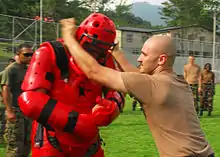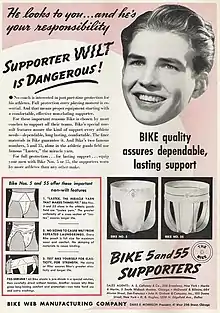Protective gear in sports
Personal protective equipment serves an integral role in maintaining the safety of an athlete participating in a sport. The usage and development of protective gear in sports has evolved through time, and continues to advance over time. Many sports league or professional sports mandate the provision and usage of protective gear for athletes in the sport. Usage of protective gear is also mandated in college athletics and occasionally in amateur sports.[1]

A maximum-safety protective gear for multiple sports training

Soft-type equipment for family sports and weekend activities

A full-body protective gear variant
American football
- football helmet
- eyeshield
- rib protector
- shoulder pads
- jockstrap with or without a cup pocket and protective cup
- hip, tail, thigh, knee pads
- mouthguard
- Gloves : Gloves[2] can help a receiver keep his hands more warm and protected in poor weather.
- cleats/shoes
Association football

jock strap
- jockstrap with or without a cup pocket and protective cup
- shin guards
Baseball
- batting helmet
- Gloves
- batting gloves
- cleats
- Shin, elbow, upper arm guards
- Hand and wrist guard for runners
- chest protectors, shin guards, and a helmet with a face mask for catchers
- jockstrap with a cup pocket and protective cup
Basketball
- Protective sports glasses or sports goggles, which are also available with prescription lenses.
- jockstrap (optional)
Bowling
- Bowling Gloves optional
Cycling
- jockstrap (optional)
- jockstrap with a cup pocket and protective cup for mountain biking
- spandex shorts
- helmet
Cricket
- Helmet
- Leg pads
- Arm guard
- Jockstrap with a cup pocket and protective cup
- Gloves (for batting and wicketkeeping)
- Thigh pad
Extreme sports
- jockstrap with a cup pocket and protective cup
Fencing
- Mask
- Jacket
- Chest Protector
- Plastron
- Breeches
- Glove
- Socks
- jockstrap with a cup pocket and protective cup
Figure skating
- pole harness
Golf
- Clothes
- Club(s)
- Glove(s) (Not necessary and usually only worn on the opposite to dominant hand)
Field hockey
- shin guards
- mouthguard
- Helmet (Goalkeeper)
- Padding (Goalkeeper)
- jockstrap with a cup pocket and protective cup
Horse racing
- Hat
- Body Protector
- Boots
- Gloves
- Breeches
- jockstrap
- Goggles
Ice hockey

National Hockey League goaltender wearing the required PPE to play.
- Shin guards
- Mouthguard
- Helmet
- Shoulder pads
- Elbow pads
- Jock (males) or jill (females)
- Ice pants or protective girdle
- Neck guard
- Gloves
- Specialized protective equipment for goalkeepers (Mask, pants, chest protector, leg pads, skates with toe protection, blocker, catcher, hockey jock or jill)
Martial arts
- jockstrap with a cup pocket and protective cup
- High Gear suit
- Compression shorts
- bandage
- Mouth guard
Racquet sports
- jockstrap with a cup pocket and protective cup
In Squash: Goggles to protect the eyes from the ball
Underwater Hockey
- Helmet
- Gloves
- Mouthguard
- Twin-lens diving mask
Volleyball
- Knee pads
- Elbow pads
- Palm guards
- Anklets
References
- "Protective Wear during Sport - Sports Injury Prevention | Sports Medicine Information".
- "Top 10 Best Football Gloves for Wide Receivers in 2021 -". 13 August 2021.
- "Ice Warehouse - Package Deals". www.icewarehouse.com. Archived from the original on 2015-02-17.
This article is issued from Wikipedia. The text is licensed under Creative Commons - Attribution - Sharealike. Additional terms may apply for the media files.